

Filename: me.jpg
Date: May 2001 (goodbrush.com)
About: Craig Mullins self-caricature.
It begins in early March 1995. A compressed file appears on the internet, before the internet was even a thing. The file was called "Incredible Marathon Render" inside was an image entitled "Marathon Image.pict" and a text document entitled "You there - read me!" by someone with the initials CH. It read:
I did not create this. It was found on AOL originally, and came to me with no documentation of any kind. It is a compelling piece of apparently computer-rendered artwork - what I always imagined the Marathon to look like. Enjoy, and many thanks to the original author.
The Marathon Image was of a compiler (S'pht) from Marathon (see below for the original image
downloaded from the internet on March 2, 1995)
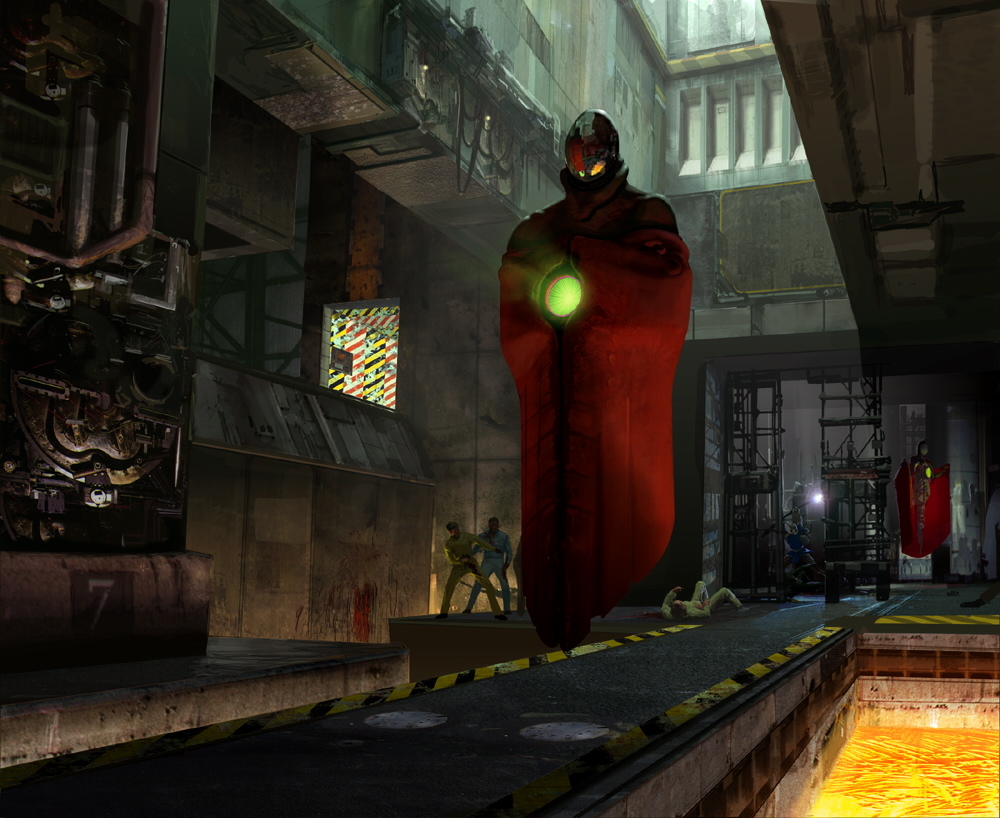
The artist, we would eventually find out, was Craig Mullins.

His name would become synonymous with Marathon and Bungie.
Speaking about his early Marathon work in a 2013 interview Craig remarked:
In 1994, I think Marathon came out at the very end of the year. I remember playing it over Christmas break. A few months later, I did some fan art. It circulated around the net for a while and found its way to Bungie. They were working on Marathon 2 by then and asked me to make chapter screens for the new game. At this point, games came on floppies, so no animations or cut scenes were possible. I think there were ten chapters/levels in Marathon 2, so I did ten illustrations.
The creation date on the original compiler image was 14 February 1995 which corresponds
with what Craig says above. Craig did at least 5 Marathon images prior to his work on Marathon 2
for Bungie.
Claude Errera was the first person to collect these together and create a page devoted to the Marathon Art of Craig Mullins at his university site ese.ogi.edu (aka Marathon HyperArchive NorthWest) in mid-July 1995
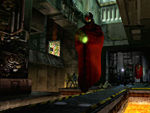
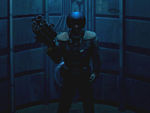
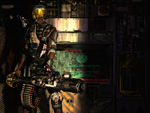
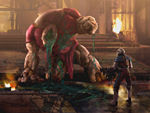

A few days later on July 20, 1995 Claude posted the following announcement on usenet:
A few days ago, I put up a page devoted to the artwork of Craig Mullins, a graphic artist with some amazing ideas about how Marathon looks. The images I placed on that page were the highest resolution floating around at the time. Well, it turns out that Craig never uploaded the full versions of most of these images, because (until recently) their biggest exposure was on AOL, and few people are willing to pay AOL rates to download 1.5 meg images.There are many more people with access to the world wide web that don't have this kind of restriction, so the full versions are being made available. (The smaller ones will be left-why shut out those with slower/more expensive connections?)
All these images can be found at
http://www.ese.ogi.edu/pub/entertainment/marathon/pictures/Craig_Mullins.html
Check 'em out! For those of you who already downloaded the smaller versions and are wondering if the new versions are worth it, here's an example of the level of detail:
In Marathon Marine 2, at about the middle of the image and level with the marine's shoulder, there's a DANGER label on the structure behind the marine. There are 5 lines of text below the word DANGER; lines 1 and 3 read "Emergency destruction system" and "Failsafe warning", respectively. Can you read this on your version? ;)
July was also the month that Bungie announced Marathon 2: Durandal. Part of the
press release read:
Combine this with new artwork and sounds, maps that are more carefully constructed and designed for both combative and cooperative network play, and a storyline infused with mystery and menace, and you've got a sequel deserving of the name Marathon.
Unsurprisingly Craig Mullins was approached by Bungie to do artwork for Marathon 2: Durandal.
The Marathon Scrapbook provides details about Craig's early work for Bungie and the freedom he was given interpreting the designs and situations in the game:
I was approached by Bungie a few months before M2 came out and we discussed chapter screens, new sprites and textures, etc. Alex sent me the chapter overview and I started mulling things over.I was initially leery of doing the chapter screens because time was very short for 10 images and other work that had been long planned was already in the works. My friend David Santiago twisted my arm to do them, so I agreed but they would not be as finished or well planned as I had hoped. Most of the M2 screens were done with no drawing and on the fly. Pour some paint out and rotate, distort, filter, hmmm, looks like a trooper in a nunnery... lets go with that.
I always liked to freely interpret the designs and situations in the game. I worried that the purists might not like that, but the Marathon universe is very large and so much takes place off-screen and is only hinted at in the terminal texts. I wanted to keep the feeling of expanding what was only suggested and go beyond what was already there. What, the marine with the Pfhor staff? Huh? Why not? So much was already done to try and get around the limiting factors of the games rendering engine. The terminal texts suggests that same variety that I hope my pictures do... It was enjoyable to start something and let it evolve and not know where it would end up. Too much of my commercial work is to spec anyway.
Marathon 2: Durandal shipped in late November 1995 and contained nine Chapter screens
and a Final screen.
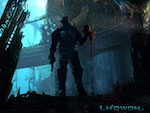

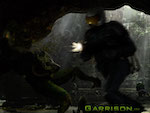
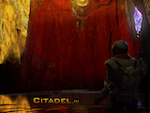
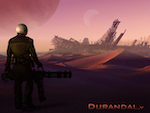
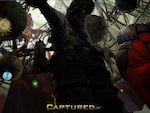
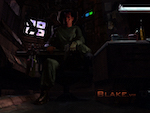
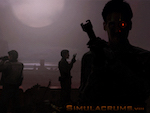
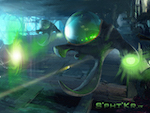
While the nine Chapter screens are clearly by Craig Mullins the creator of the Final screen wasn't initially clear. However Bungie would later release it as one of sixteen Marathon Desktop Pictures on the Marathon Trilogy CD in May 1997 calling it "Mullins 10.pict".
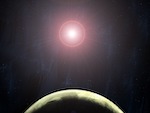
In February 1996 Bungie announced the development of Marathon Infinity. When the Infinity
demo was released in August 1996 it was clear that Craig Mullins was back.
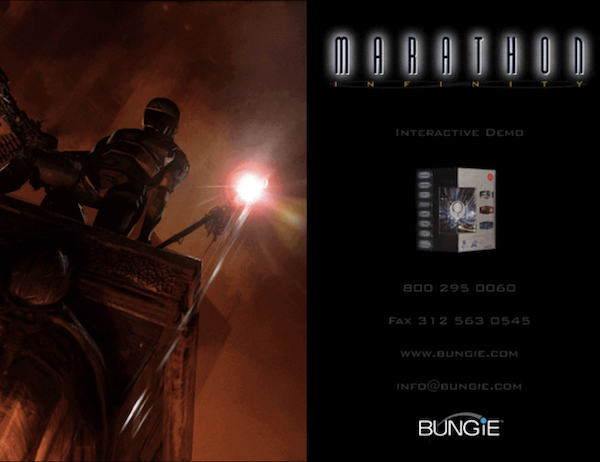
Unfortunately Craig did only two Chapter screens for Marathon Infinity. During beta testing in late August 1996 Greg Kirkpatrick lamented the fact that there were only two Chapter screens. He wrote:
(to answer a question that i'm sure you're all wondering - 2 chapter screens, an end screen, and the prologue screen.) Yeah, I wish there were more of them as well...
The prologue and end screen were created by Randy Reddig.
However when Marathon Infinity shipped in mid-October 1996 there were in fact three Chapter screens by Craig Mullins.
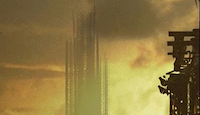
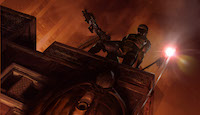
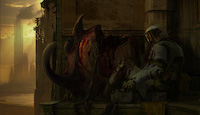
Marathon fans were quick to spot how this 'magic' had been accomplished.
Shortly after the release of Marathon Infinity Claude Errera announced the closure of the
Marathon HyperArchive NorthWest (including the Craig Mullins art gallery) and
its move to marathon.org (aka Marathon Central). Claude explained in an
alt.games.marathon post that he and his family were embarking on an 18-month, around-the-world trip,
beginning in December, 1996.
Craig Mullins would later go on to do a piece of art for the Marathon Trilogy Box Set (released May 1, 1997), specifically the
inside picture for the CD cover.
(Photograph courtesy of Bob-B-Q)
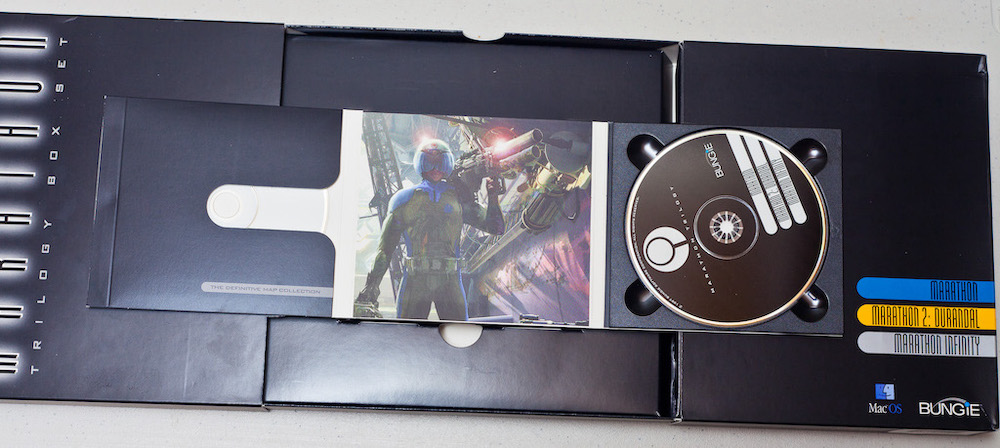
In July 1997 Simon Brownlee, the new maintainer of the Craig Mullins art gallery at Marathon Central,
managed to get his hands on some unreleased Marathon Trilogy artwork by Craig Mullins.
Craig described the two pieces he sent to Marathon Central on alt.games.marathon as follows:
The first is the marine w/spanker from the inside of the cd cover. The second is a compilation of the ideas and early comps that I went through to arrive at the final image. I think Bungie liked the top one the best.
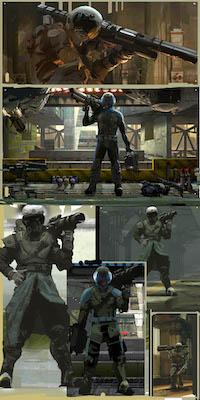
In the same month as the Trilogy artwork made its first public appearance on Marathon Central
Craig opened his own web page at cyberverse.com for his artwork. While most of this
art was not related to Marathon there was one Marathon piece to be found.
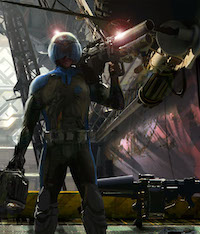
Concerning this piece Craig wrote:
This is the one Marathon related image here. Marathon is a game by Bungie software where you run around trying to take your colony spaceship back from a bunch of alien slave traders. Basically you blow stuff up. That is the rocket launcher in the Marine's hand- the favorite weapon in network play.
Describing his new web page in an alt.games.marathon post in September 1997 Craig wrote:
This page, however, is not a full representation, because I work for some very big companies (read ninja lawyers) and they don't want their images released.So the page includes some odd images- either old school projects or jobs for clients who don't care anymore.
Craig's web page offered a short bio which read:
I was trained at Art Center College of Design as a product designer and traditional illustrator. I went digital about 3 years ago. I use Photoshop 99 percent of the time and work at resolutions ranging from 3000- 5000 pixels across. This goes higher as hardware improves. If you are looking for matte work, I can do the compositing and simple 3-d work as well.
Another place for Craig Mullins artwork was RuGGeR's Tavern a Hotline Server which could
only be accessed using the Hotline Client. Established in 1998, RuGGeR's Tavern offered chat, message board and file sharing functions.
RuGGeR (aka James Pillar) had a knack for getting unseen Marathon artwork from Craig or
large versions of previously posted pieces. For a period of time RuGGeR's Tavern was
the place to be.
In January 1999 Craig's cyberverse page closed and was replaced by goodbrush.com. The entry
page was no-nonsense, clean and simple.
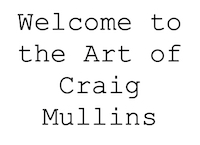
Reflecting what was perhaps an emergence of the internet as a viable commerce vehicle Craig's goodbrush page was a much larger affair containing final and concept artwork, descriptions on how he worked and comments on many of the pieces he had created.
Craig's new page also carried a lengthier bio which read:
A Brief BiographySo I won't have to practice my typing too much..
I was born in 1964 in California and moved to Ohio at three. At 18 I set off for California and have lived in the LA area since then. I went to Pitzer College in Claremont, Ca, for two years and then went to Art Center College of Design to study product design. Well, I was better at drawing cars, and that lead to 6 months at Ford in Detroit designing them. My design sense was a little weird to be of any value to anybody in Detroit, so I returned to Art Center to study illustration. There I was as conservative as I was off-the-wall in Industrial Design. I just wanted the academic skills of drawing and painting, no soapbox, please. I finally did graduate in 1991.
I was doing a lot of concept painting for architects and theme parks and that slowly lead to contacts within the film biz. I was introduced to the computer first at Ford in 87 in the form of a "Dubner PaintBox." I wonder where that ponderous bulk is today? It did pretty much what photoshop does. I was working for a short time at a big effects house and was introduced to Photoshop by one of it's creators, John Knoll. I went all digital for commercial work in 1994.
A fellow Art Center classmate (Richard) posted the following about Craig in 2003:
I went to school (Art Center) with Craig and I sincerely wish I had a tenth of his skill with color, lighting and composition.I vividly remember showing up to class crits with the minimum number of lame b&w sketches, then Craig shows up with twice the number of highly detailed and rendered scenes - in full color! I mean we literally had sketches all over the walls of objects only slightly more complex than shaded primitives, and Craig puts up these elaborate WW2 battle scenes with all kinds of vehicles and troops and fire and smoke, all beautifully atmospheric and with the same powerful pallets he still uses. It was beyond humbling.
Below is a rare shot of Craig's home studio from the late 90s.
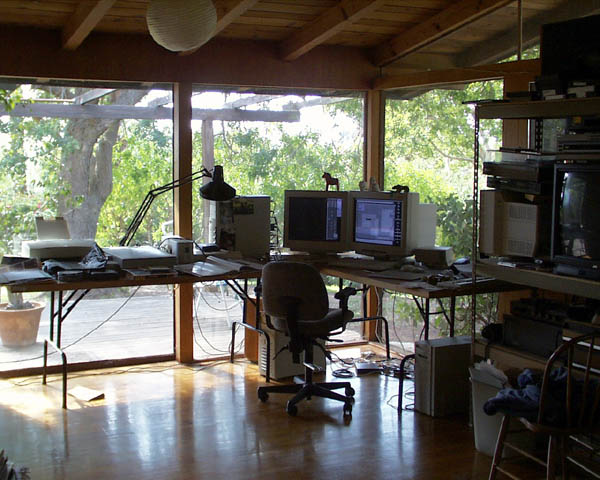
Filename: sd_hideout.jpg
Date: January 1999 (goodbrush.com)
About: Craig Mullins studio
January 1999 also saw the creation of a new Bungie fan site bungie.org. However, it wouldn't
be until January 2002 that the Craig Mullins art gallery at Marathon Central would move to
bungie.org and expanded to include Marathon 2 and Infinity Chapter screens and some artwork that
Craig had done for the 3rd party Marathon scenario 'Devil in a Blue Dress'. This gallery is still alive and well today
under the stewardship of Claude Errera. See http://marathon.bungie.org/temp/Craig_Mullins.html
In a gamasutra.com feature in January 2000 Craig provided some additional insights about his work under a number of headings.
Inspiration:
I like the academic artists of the 19th century, and some of the illustrators from this century.
Favorite Game Art:
There was an illustration for the launch of Dark Forces that I really liked. I don't know who did it, but it was very nicely done and original.
Why I Got into the Industry:
To diversify, to do something different... and I like games.
Tools I Can't Live Without:
Photoshop. I paint everything using it. I could use painter I suppose but it does not have the flexibility and strightforward UI the PS does.
Music I Listen to While Working:
Wagner and Debussy
Craig continues to update goodbrush.com to this day. His site has undergone many face lifts
over the years and at one stage it had over 20 Marathon images on display. Some were variations
on previously released pieces.
In compiling this art gallery I have attempted to use the earliest version of the image files available.
Over time some images have been modified for one reason or another. I have
attempted to trace the history of these modifications if they have been made by Craig or Bungie.
In addition, I have used Craig's own descriptions of his work where these have been given.
I have taken some liberties in adding a number of pieces of artwork that are not Marathon-related. I justify my reasons for doing so where they appear.
I have stolen extensively from Craig's old web pages to give old-timers like myself that déjà vu feeling. Like Feathers McGraw, his self-portraits, nick-nacks and the like. See if you can spot them.
Enjoy.
PS if you have read this far congratulations. Few people read much these day and even fewer appear to be interested in historical stuff.
You are in the minority.